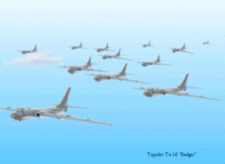Tupolev Tu-16
“Badger Badger Badger Badger Badger Badger Badger Badger Badger Badger Badger Badger Badger”
– Weebl on Tupolev Tu-16
The Tupolev Tu-16 "Badger" is a Soviet-made heavy jet bomber.
The Tu-16 was first deployed in 1954. Most countries have moved on, but China still uses them because they are too cheap to upgrade to more modern aircraft.
Badger Badger Badger[edit | edit source]
Around 1950, the Soviet Union needed a new strategic bomber to compete with the Evil Capitalist Dogs and replace the Tu-4 "Bull" which was a counterpart to the Boeing B-29 Superfortress.
The Tu-4 was propeller-driven, but with developments in powerful turbojets, a jet-powered heavy bomber was made possible.
From 1954 until 1962, over 1500 Tu-16's were constructed. Production probably slowed around 1958 when China started manufacturing their own, as everyone knows technology is outdated by the time China gets a hold of it.
It was also exported to Egypt, Indonesia, and Iraq because the Union of Soviet Socialist Republics loves making money off their old junk (apparently not enough to prevent those Capitalist Dogs with a vastly inferior economic system from winning the Cold War though, what a shame).
A civilian version for passenger service was also made, the Tu-104 "Camel".
Mushroom Mushroom[edit | edit source]
The Tu-16 is capable of carrying conventional 9,000 kg (20,000 lb) dumb bombs. A more audacious Badger could also carry an atomic bomb.
They were armed with several Nudelman-Rikhter NR-23 23mm cannons for self-defense located in turrets on the top, bottom, and tail. Of course these were nothing compared to the nuclear weapons it could drop.
While it was originally intended to carry free-fall explosives like the FAB-9000, it was later outfitted to utilize Soviet cruise missiles such as the AS-1 "Kennel", AS-2 "Kipper", and AS-6 "Kingfish". These could be armed with conventional explosives or nuclear warheads. The Badger-B could carry the very large AS-1, which was modeled after the Soviet MiG-15 "Fagot" jet fighter.
The B-29 Superfortress which the Tu-16's predecessor was rivaling was the aircraft that dropped the bombs on Hiroshima and Nagasaki, of course, the Badger would be much more capable of such carnage then the older prop-driven designs.
A Snake! A Snake![edit | edit source]
In order to better evade enemy fighters, the early designs were made with speed in mind, intending to double the speed of the Tu-4. The prototypes were the first Soviet aircraft with swept-wings and expected to have a speed just under mach 1.
The very first prototype, "82", flew on the 24th of March 1949 and reached 934 kph (580 mph) which was only 20% faster than the Tu-4.
Prototype "88" which was to become the Tu-16 Badger exceeded expected speeds.
While these higher speeds make it harder for enemy fighters to catch up, they can't outrun the AIM-9 Sidewinder which entered service in 1956 and travels at mach 2.5 up to 18.2 km (11.3 miles).
The Sidewinder is an air-to-air, short-ranged, heat-seeking missile. It is named for the Sidewinder rattlesnake which can sense warmblooded prey using infrared sensory organs based on the sides of its head.
See also[edit | edit source]
External Links[edit | edit source]



